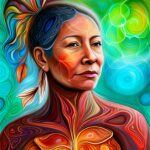The Role of Spirituality in Indigenous Healing
A Journey Through Traditional Wisdom
In the heart of indigenous communities, there lies a profound connection between spirituality and healing—a bond deeply rooted in centuries-old traditions and beliefs. For these communities, healing transcends the physical realm, delving into the spiritual and emotional aspects of well-being. This article explores the intricate relationship between spirituality and indigenous healing, highlighting its significance and impact on the healing process.
The Essence of Spirituality in Indigenous Cultures
Spirituality in indigenous cultures is not merely a facet of life; it is the very fabric that weaves their existence. It represents a holistic understanding of the world, where every element of nature is interconnected and sacred. This spiritual worldview is fundamental in shaping the principles of indigenous healing practices.
For many indigenous people, spirituality is a way of life. It encompasses their daily activities, rituals, and customs, guiding their interactions with both the natural world and the community. The spiritual connection to the earth, ancestors, and the cosmos is intrinsic to their identity and way of understanding health and illness.
Indigenous Healing: A Holistic Approach
Indigenous healing practices are diverse, varying from one culture to another. However, they share a common thread: the belief in the balance and harmony of body, mind, and spirit. Illness is often perceived as disharmony within this triad or a disruption in the individual’s relationship with the spiritual world.
Healers, often referred to as shamans, medicine men or women, play a crucial role in restoring this balance. They are not just healers but also spiritual guides, possessing deep knowledge of medicinal plants, rituals, and ceremonies. Their methods may include herbal remedies, energy healing, purification rituals, and spiritual counselling, all aimed at treating the whole person rather than just the symptoms.
The Significance of Rituals and Ceremonies
Rituals and ceremonies are pivotal in indigenous healing practices. They provide a space for the community to come together, reinforcing social bonds and collective well-being. These rituals often involve prayer, music, dance, and storytelling, creating a therapeutic environment that nurtures both the patient and the community.
One such example is the sweat lodge ceremony, common among Native American tribes. This purification ritual is believed to cleanse the body and spirit, facilitating healing and spiritual renewal. Participants enter a dome-shaped structure, where heated stones and water create steam, symbolizing the womb of Mother Earth. This intense physical and spiritual experience is guided by a shaman, who leads prayers and chants, aiding the participants in their journey of healing and self-discovery.
The Role of Ancestral Wisdom
Ancestral wisdom is a cornerstone of indigenous healing. It encompasses the knowledge passed down through generations about medicinal plants, healing techniques, and spiritual beliefs. This wisdom is not static; it evolves with each generation, adapting to the changing needs of the community while preserving its core principles.
In many indigenous cultures, the relationship with ancestors goes beyond reverence; it is an active engagement. Ancestors are often invoked for guidance and assistance in healing processes, as it’s believed that they hold the knowledge and power to aid in the restoration of balance and harmony.
The Impact of Spirituality on the Healing Process
The impact of spirituality on the healing process in indigenous cultures is profound. It provides a sense of hope, strength, and resilience, essential elements in overcoming illness. This spiritual approach to healing focuses on the root causes of the ailment, be it emotional, spiritual, or physical, offering a comprehensive path to recovery.
Moreover, this spiritual journey is not a solitary one. It involves the community, creating a support system that plays a vital role in the healing process. The collective participation in rituals and ceremonies reinforces the individual’s sense of belonging and connection, vital for emotional and spiritual well-being.
The Relevance in Contemporary Times
In our modern world, where medicine often focuses on symptoms rather than underlying causes, the principles of indigenous healing can offer valuable insights. The holistic approach, emphasizing the balance of body, mind, and spirit, can complement modern medical practices, leading to more effective and compassionate healthcare.
Furthermore, the indigenous perspective on living in harmony with nature presents a crucial lesson in our times of environmental crisis. It reminds us of our responsibility to the earth and the importance of sustainable living practices.
Conclusion
The role of spirituality in indigenous healing is a testament to the enduring wisdom of these cultures. It highlights the importance of viewing health and healing as a holistic process, encompassing physical, emotional, and spiritual well-being. As we seek to navigate the challenges of the modern world, the insights from indigenous healing practices can guide us toward a more balanced, connected, and harmonious way of life.
In embracing the teachings of our indigenous counterparts, we not only honour their wisdom but also open ourselves to a richer, more profound understanding of health and healing. It is in this fusion of ancient wisdom and modern




